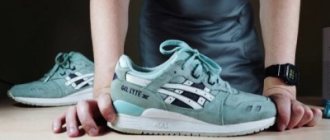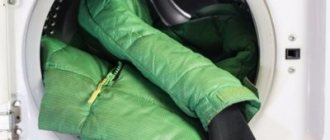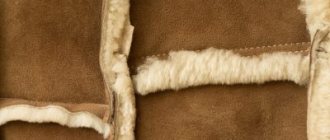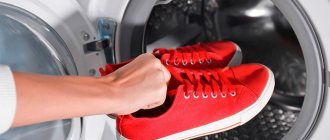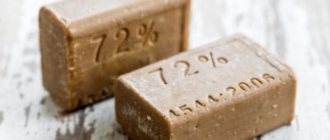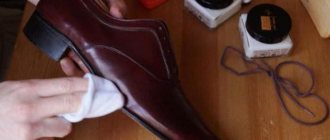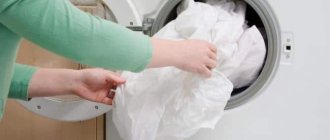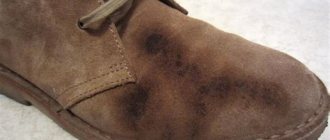There are several effective and inexpensive ways to clean mold and dirt from a tent at home without going to the dry cleaner.
When asking the question “How to wash a tent?”, avid travelers should take into account the nature of the dirt and the type of material. For example, high-quality tents made of good water-repellent material can be simply wiped with a damp cloth to remove the top layer of plaque. If stains on the tent are left by spilled oil or red wine, heat treatment is necessary, but the water temperature must be regulated very carefully.
Is it possible to wash a tent?
Over the years, a tent naturally becomes dirty, both inside and out. Dampness on a hike can even cause mold to appear. The issue of washing will affect this product one way or another.
In the washing machine it is easy to damage the water-repellent impregnation and deform the item, so this method is not recommended. As a last resort, when you cannot do without the device, make sure that the weight of the tent does not exceed the permissible weight for loading into the drum.
Typically, tents are cleaned by hand, wet or dry.
Proper tent care
Proper care of travel equipment is no less important than proper operation. The tent is pitched during camping conditions, sometimes in bad weather, as a result of which it quickly deteriorates, the fabric wears out, and becomes saturated with the smell of fire and earth. Often, after it ends up at home, some careless tourists simply put it away in a case for storage, but this is absolutely wrong.
Here are some recommendations for proper care, so that you don’t have to often be puzzled by questions about whether the tent can be washed in a washing machine and generally cleaned of serious dirt and mold:
- Before you assemble the tent, you need to let it dry. Rain, dew, and humid air greatly harm matter, which is why it very quickly ceases to perform its functions.
- If it was not possible to dry the tent in the field, then this must be done at home. To do this, place it in a large room and let it dry. If you put away the equipment while it is damp, there is a high risk of mold growing.
- If grease or oil stains are found, they should not be removed. As a last resort, you can use special tools for working with tarpaulins. If there is none, let the tent dry and store it.
- Pieces of earth, needles, sand and other small debris must be swept out of the tent before putting it in a protective case for transportation and storage.
How to restore the protective layer
If the protective layer is slightly damaged during washing, don’t panic! Purchase a product to restore the protective coating and return the product to its former properties. There are now a lot of options for such products on the market.
Let's look at the most popular of them:
- Nikwax . It is considered one of the highest quality impregnations. When using, it is important to follow safety precautions and work away from open flames. This product can be either sprayed or applied with a sponge, brush or even a cloth. Do not throw away the bottle after treatment - you will need the product to restore awnings, overalls, jackets and other travel equipment. For half a liter you can pay an average of 700 rubles. This is enough to saturate 7 square meters of fabric.
- Mcnett tentsure. A good impregnation, designed specifically for fabrics such as tents. Apply with a roller or brush. It is best to apply in two layers, allowing each to dry. Thick layers when applied are unacceptable, otherwise the effectiveness of the product will be lost.
- Waterproofing spray. This impregnation is made on the basis of silicone and is a universal product. It is used widely and actively for the restoration of tent fabrics. The downside is the high consumption and small volume of packaging, only 0.3 liters. The bottle is enough to treat only two “squares”. One such can costs around 500 rubles. Suitable for treating minor damage to folds.
How to prepare for washing
Once you start doing laundry, you need to understand the capabilities of your washing machine. Dirty items are placed directly into the drum of the device, after which the door must be closed tightly. The amount of laundry that can be washed at one time depends on the parameters of the specific washing machine and the type of items. One of the main parameters that people rely on when purchasing such equipment is the loading volume, indicated in kilograms. It is worth considering here that the maximum capacity declared by the manufacturer applies to dry laundry.
The washing machine always indicates the maximum weight of laundry it is designed for.
There are also recommendations regarding the type of material:
- When washing delicate fabrics (silk, wool), you should not do a full load - it is recommended to fill the drum no more than a third of the maximum possible level;
- when washing synthetics, the drum is filled to 50%! (that is, if the maximum permissible load is 5 kg, no more than 2.5 kg of clothes should be placed);
- cotton and linen can be loaded in the full amount specified for the washing machine.
When washing linen and lace, it is necessary to place things in special bags or balls so that the fabric is not damaged.
After the laundry is placed in the drum, you need to pour in the detergent, select the washing program and press the “Start” button.
We recommend: How to properly wash sheepskin
Care, mold removal
Modern tents are made of durable materials that are additionally treated with a water-repellent compound. Manufacturers do not recommend washing such products in a washing machine, since under the influence of friction and when using detergent compositions, the material can be damaged, in particular, the impregnation can be removed from it. Subsequently, such a tent will lose some of its functionality; it will allow moisture to pass through, which means it will be uncomfortable to live in it in the rain.
To maintain the decent appearance of the tent, as well as remove dirt from it, you should clean it immediately after use.
Don’t rush to immediately disassemble your campervan and put it in your backpack. Let it dry thoroughly, roll up the already dry material. If climatic conditions do not allow you to do this right away, then when you arrive home, the first thing to do is dry the tent fabric. If you leave wet material for storage, mold will certainly grow on the tent, which will be difficult to remove.
Mold appears so quickly on wet material lying in the dark and warm that it should not be underestimated. For serious mold to appear on the tent, 2-3 days of storage will be enough. If a damp tent has been lying around for several weeks, it will be extremely difficult to remove mold from it.
It will be easier to throw away a cheap tent, but you will have to try to save an expensive one. To do this, you can use the following recommendations:
- In hardware stores, sporting goods stores, and tourist stores, special compounds for combating mold are sold. Typically these formulations are in the form of a spray. This spray should be used to treat mold-affected areas of the tent, and then leave it to dry and ventilate for a long time.
- Traditional methods of combating mold are based on the use of vinegar, or more precisely, a vinegar solution. Usually this solution is created in the bathroom in large quantities, 70-80% water and 20-30% vinegar are poured. The resulting solution will not harm the tent fabric or impregnation, but will help remove mold. The tent is loaded into the bathtub, and the affected areas are treated with a soft cloth or soft-bristled brush.
- Another option involves using regular laundry soap. You should wash the areas affected by mold with a soapy solution, removing any visible dirt. Then you need to prepare another soap solution and soak the tent in it for several hours. After soaking, the product is rinsed in plenty of clean water to completely remove traces of soap from the fabric. After drying the tent, you can evaluate your work.
If you decide to choose traditional methods for removing mold, then you should be extremely careful. It is advisable to even test them first on a small area to make sure that the impregnation will not be affected after such treatment.
By the way, many tourists do not know that setting up a tent in direct sunlight is not recommended, since ultraviolet radiation can also damage the impregnation of the fabric.
Please note that it is not recommended to remove difficult stains from the tent material, for example, oil or greasy marks. Using strong detergents can also remove the impregnation from the fabric, which will make the tent less functional.
Ways to wash a tent
Method 1. Washing by hand
In such cases, you should not unfold the entire tent. It is better to wash only those areas that seem the dirtiest to you. Take a sponge (preferably soft, without seals), a basin with warm water, a cleaning agent (if powder, then dissolved in water, so that the granules do not damage the outer tissue) and begin to carefully wash the stains. You shouldn’t be too zealous: if you “wipe the hole”, i.e. damage the impregnated top layer, the tent may begin to partially let in the cold.
We recommend: How to wash crib bumpers without damaging them?
Method 2. Machine washing
You tried to remove the stains by hand, but it didn’t work. Now the question arises: how to wash a tent in a washing machine? Yes, of course, you can try the machine. However, you should be very careful with the choice of washing mode and powder: only “Delicate” mode, temperature – no higher than 30 degrees. It is advisable to use liquid powder in capsules. If this is a little expensive for you, then you can take ordinary powder, but do not add too much of it. There is no need to rinse fabrics into the machine - there is no need for a lavender smell in the tent.
After machine washing, it is best to dry the product unfolded on a carpet or boards, as, for example, wool products are dried. First you need to wring it out, wrapping it in a large rag. Mechanical spinning and mechanical drying should never be used!
Method 3. Washing with vinegar
A solution of water and vinegar will not clean serious stains, but it may help fight mold.
First, dilute the water with vinegar in a ratio of 7:3 (for example, seven glasses of water to 3 glasses of vinegar). We leave the tent in this solution for several hours, after which we rinse it under running warm water. Particularly dirty areas can be easily scrubbed with a brush.
Advice! It is necessary to dry the tent after any type of washing in a dark place so as not to damage the quality of the impregnation.
Many housewives are annoyed after washing when they see that their colored linen has faded. How to wash correctly, Items made of viscose look very beautiful and bright, but due to improper care they become very fast, Natural fabrics are expensive, but cause certain difficulties when washing. To remove contaminants you will need, Properly washing and drying a down jacket is a whole science, because due to poorly selected
Rules
How to properly machine wash a tent?
- Make sure that the tent fits into the washing machine drum and that its weight is less than or equal to the maximum load of the machine.
- Set up your tent somewhere clean, dry, like grass in your yard.
- Spray the tent fabric on one side first and rub it with a bar of laundry soap, then do the same procedure on the other side.
- Place the soap-rubbed tent without folding it into the drum of the washing machine.
- Set the washing mode without heating and spinning, and the drum should not rotate at a speed of more than 500 revolutions. Do not use powder or gel.
- Wait until the wash is finished, then remove the tent from the drum, let the water drain, and dry the tent. It is very important that the tent is completely dry.
- Carefully inspect the tent; all suspicious places should be treated with a spray that restores the protective layer of the fabric.
Important! Even a very high-quality tent can be machine washed only once or twice during its entire lifespan. If you wash it more often, it will most likely deteriorate and even the spray will not help.
Now let's figure out what compounds can restore the protection of a tent if you do damage it during washing. There are many options on the market, but there are only a few of the best formulations:
- Nikwax. One of the best impregnations for tents. It must be used carefully, away from sources of open flame. Nikwax can be applied to the damaged area using either a spray bottle or a cloth or sponge. Using Nikwax impregnation, you can restore awnings, backpacks, overalls, jackets, gaiters and the like. The average cost is 700 rubles for a 500 ml bottle, which is enough to saturate about 7 m2 of material.
- Mcnett tentsure. A very good impregnation for restoring damaged protective layers on tent fabric. Impregnation can be applied to damaged areas with a brush or small roller. The impregnation should be applied in a thin layer to the fabric, let the layer dry, and then apply a second layer and let it dry again. Do not apply impregnation in a thick layer - it is ineffective.
- Waterproofing spray. A universal silicone impregnation that is excellent for restoring tent fabric. The only negative is that the impregnation disappears quite quickly, and the capacity of the can is small - only 300 ml. It is enough to cover approximately 2 m2 of damage. The average cost of a 300 ml can is 470 rubles.
Ways to wash a tent
Method 1. Washing by hand
In such cases, you should not unfold the entire tent. It is better to wash only those areas that seem the dirtiest to you. Take a sponge (preferably soft, without seals), a basin with warm water, a cleaning agent (if powder, then dissolved in water, so that the granules do not damage the outer tissue) and begin to carefully wash the stains. You shouldn’t be too zealous: if you “wipe the hole”, i.e. damage the impregnated top layer, the tent may begin to partially let in the cold.
Method 2. Machine washing
You tried to remove the stains by hand, but it didn’t work. Now the question arises: how to wash a tent in a washing machine? Yes, of course, you can try the machine. However, you should be very careful with the choice of washing mode and powder: only “Delicate” mode, temperature – no higher than 30 degrees. It is advisable to use liquid powder in capsules. If this is a little expensive for you, then you can take ordinary powder, but do not add too much of it. There is no need to rinse fabrics into the machine - there is no need for a lavender smell in the tent.
After machine washing, it is best to dry the product unfolded on a carpet or boards, as, for example, wool products are dried. First you need to wring it out, wrapping it in a large rag. Mechanical spinning and mechanical drying should never be used!
Method 3. Washing with vinegar
A solution of water and vinegar will not clean serious stains, but it may help fight mold.
First, dilute the water with vinegar in a ratio of 7:3 (for example, seven glasses of water to 3 glasses of vinegar). We leave the tent in this solution for several hours, after which we rinse it under running warm water. Particularly dirty areas can be easily scrubbed with a brush.
Advice! It is necessary to dry the tent after any type of washing in a dark place so as not to damage the quality of the impregnation.
Types of materials for awnings
To solve the problem of the possibility of washing a collapsible tent, it is necessary to understand the characteristics of the materials from which it is made. About ten years ago, all tents (military, for travelers) were canvas.
Today's tents are multi-layered. The outer part of the awnings is made of dense, moisture-impregnated materials, the inner layers are made of breathable (membrane) materials that are no less durable.
The material of today's tents is of better quality than tarpaulin, impregnated from moisture and dirt, but it still needs care.
Today's tents are made from fabrics containing special fibers:
- UV-resistant, polyester. Strong, do not stretch when wet. The manufacturer uses high-quality materials (for example, lavsan) inside and out.
- Less resistant polyamide fabrics (nylon, nylon). Deformed by water and ultraviolet radiation. These materials are used to decorate the tent from the inside (walls and floor).
- When making tents, more than one type of fabric is used (mixed), but always with cotton fibers. They are also used for interior decoration.
To add strength, manufacturers use the latest technologies:
- weaving, which increases the strength of the material;
- adding thick synthetic threads that prevent the fabric from unraveling;
- They are treated with a special impregnation to prevent getting wet, which is important for raincoat tents.
The price depends on the properties of the awning. Canopies made of polyester fabrics are more expensive, but the quality of the material is much higher. Such a house will serve longer (up to 10 years), with careful handling and proper care.
How to wash: tips
To begin, simply go over the fabric with a brush dipped in soapy water. Apply the cleaning solution to the dirty areas, wait 10-15 minutes and remove it with a clean damp cloth. If you do this after every trip, the tent will not become covered with a coating that is difficult to wash off.
We recommend: Simple ways to whiten a white shirt at home
Many owners can easily handle dry cleaning: just brush away dust and other debris and shake out the inside. However, Miss Clean magazine notes that cleaning with soap is preferable, as harmful microorganisms can remain on the tent fabric.
Life hack Internal debris - sand, leaves, needles - can be easily removed with a vacuum cleaner.
If you want to take the risk and machine wash an overly dirty tent, follow these rules:
- Spinning is prohibited.
- Only gels or capsules - they rinse well.
- Delicate mode or hand wash function.
- Small number of revolutions.
- Do not wash if the dimensions of the tent are too large for your car - you will break the device.
- Wash only when absolutely necessary. Washing in an automatic machine may be necessary 1-2 times during the entire service life, do not abuse it.
- Use water-repellent sprays on the fabric after it has dried.
We recommend: How to properly wash clothes made with synthetic padding in a washing machine?
Total washing is also possible by hand; to do this, you will have to fill the bath with water and dissolve soap shavings in it.
A more convenient way is to lay out a tent on the lawn, wet it with a hose, rub it with a soap bar, and after a few minutes rinse the foam thoroughly. Hand washing can be done much more often than machine washing - about a couple of times per season, depending on the quality of rest.
Remember to thoroughly clean off dirt and dry your equipment after use. Keep in mind that frequent washing, especially machine washing, will reduce the performance of the tent. Take good care of it and it will serve you for a long time.
Preparation
Hooks and straps can damage the washing machine, so they must be unfastened. Other hard elements of the product are removed. For the same reason, if possible, it is better to remove plastic carabiners and latches for manual cleaning. The protruding threads on pockets, zippers, and fastenings are cut off so that they do not spoil the item during processing by catching on other parts.
Before starting the device, each contaminated area is wiped with a wet cloth. Dried dirt can cause stains on your bag when exposed to water. If there are heavily soiled areas (stains), they are removed before washing. Before the procedure, you should treat the most contaminated areas with a stain remover or laundry soap, rub with a brush and rinse. The inside of the product may also contain stains (ink, drinks). In case of heavy contamination, the bag is soaked in warm water for an hour and a half. You just need to add soap (can be grated with shavings) and baking soda.
When machine washed, the pockets and snake sections wash much less well.
How to wash a tent by hand?
It is believed that hand washing a tent is the most effective and safest. Here is an algorithm for how to wash a tent without a washing machine:
- Place the tent in a room or near a body of water to prevent dirt and water from remaining in fabric storage areas.
- Fill a bucket with warm water and add some cleaning product, such as hand washing powder. If you took the powder, wait for it to completely dissolve.
Important! Remember that if you wash a tent outdoors, then under no circumstances should the soap solution be poured into a body of water.
- Use a soapy sponge to wipe the surface of the fabric of the erected tent. Try to wring out the sponge as much as possible before washing - it will be easier to dry the equipment later and there will be no streaks on it.
- No effort should be made to wash away complex stains. This can disrupt the structure of the material, as a result of which it ceases to retain moisture and rain.
- At the end, you need to wipe the tent with a sponge without soap and let the fabric dry. Only after this can you collect and put the equipment in the case.
Dry cleaning
We have come to dry cleaning - the most gentle and harmless way to treat a tent. Cleaning has its pros and cons. On the one hand, the protective layer is intact, on the other hand, odors and dirt may remain.
So, let's start cleaning:
- Immediately after the hike, hang the product to dry.
- Straighten the product, look for stains.
- Clean the fabric with a soft brush or sponge. You can locally remove stains with soapy water.
- Arrange for drying in a ventilated place and pack the tent for the next camping season.
Let’s conclude that, in theory, it’s possible to wash a tent in the SMA, and maybe there won’t even be anything wrong with it. But always be aware of the risks when putting equipment into the drum. It is beneficial to restore the protective layer only locally; if it deteriorates completely, it will be easier to buy a new tent.
